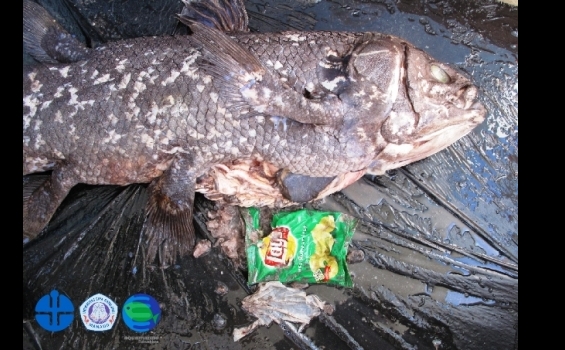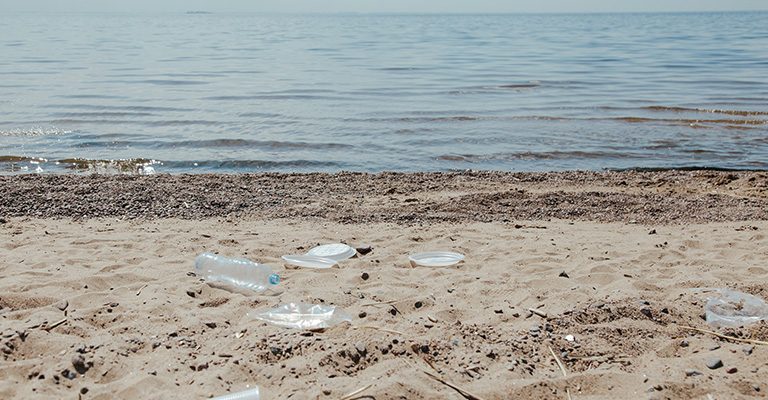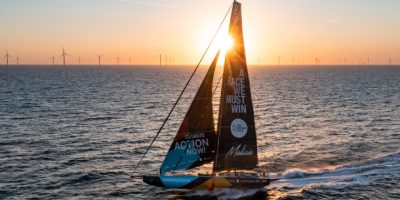By Marie-Amélie Lenaerts
French and Indonesian researchers have studied the surface drift of plastic waste in the Indonesian seas. Using numerical modelling, they observed that the majority of plastic waste that reaches the sea via Indonesian rivers washes up on the Indonesian coast rather than drifting offshore. These results also show that local authorities or non-governmental organisations can act directly on the pollution of their coastline.
In early 2020, Christophe Maes, a physical oceanographer at the French Institute IRD (Institut de Recherche pour le Développement Durable), went to Bali as part of an international symposium on global marine debris organised by APEC. There he discovered a photo of a dead coalacanth found by an Indonesian fisherman. Potential cause of death: plastic packaging from Lay’s chips found in its intestines.
The image does not leave him indifferent: “To think that such mythical fish could disappear when they have survived for hundreds of millions of years on earth, all because we are not capable of managing our plastic waste, is dramatic.

Indonesia is the second largest emitter of mismanaged plastic waste after China. A real scourge, the authorities have put in place a national plan to combat plastic waste.
Modelling plastic waste drift
Back in France, Christophe Maes agreed to take charge of the coordination of the project to monitor and model the drift of plastic waste in the Indonesian seas. This project is funded by the AFD (French Development Agency) and implemented by the IRD and the French company CLS. The aim is to understand where the plastic waste that washes up on Indonesian beaches comes from: where did it enter the sea and how did it drift?
The intention of the project is to increase knowledge of marine debris, particularly plastic, so that the Indonesian authorities can implement appropriate and effective programmes to combat coastal pollution.
60% of the particles remain near the coast
The researchers assumed that the plastic waste that reaches the sea comes from rivers with a high flow rate and which are close to areas of high urbanisation. They therefore selected 21 Indonesian rivers that combine two important parameters: a connection to the sea while passing through densely populated areas, especially at the mouth.
Using numerical modelling, they were able to launch 2 million ‘dummy’ particles from the 21 selected rivers and observe their fate over a period of 4 years.
The overall result was that almost 40% of the particles dispersed and went out to sea in the Indonesian, Indian and Pacific oceans, and around 60% remained close to the coast and ended up stranded. This result surprised the researchers: “We thought we would have much more dispersion at sea, with particles gradually leaving Indonesian waters over the years and going to the waters of other countries. But this was not the case. It was found that the particles remain in Indonesian waters, even after several years. So they are not subject to large-scale ocean dynamics“.
What explains why some particles – the majority in this case – do not move out to sea? Christophe Maes explains that once the particles arrive at sea, they are subject to various dynamic processes: ocean currents, but also the tidal effect and the residual effect of waves. It is this last parameter that seems to play a more important role than expected. When a wave passes, the particle is carried along in a vertical movement but also undergoes a slight horizontal shift. It is this singular and small spatial scale dynamic that tends to keep the particles close to the coast.
An atlas to guide authorities and associations
Coastal areas with high concentrations of particulate matter have been mapped in an atlas for local authorities. The French Minister for the Sea, Annick Girardin, handed over the atlas during an official visit in June 2021.
The atlas also shows seasonal pollution peaks, with the monsoon playing a major role.
The atlas has also been passed on to two organisations working on the ground in Indonesia: Plastic Nomad and The SeaCleaners. It is the work with these associations that allows researchers to validate the numerical models with in-situ observations. This work is still in progress.


